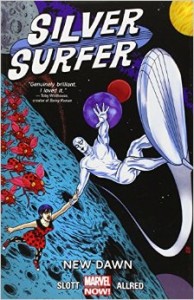Here’s some stuff I’ve enjoyed recently that I’d like to share:

The Unbreakable Kimmy Schmidt – A Netflix original series from the team that created 30 Rock. The show follows Kimmy Schmidt, tricked into joining an apocalypse cult living underground for fifteen years before she and the three other women with her were rescued. But rather than living in victim-hood and work the talk show circuit, Kimmy decides to stay in NYC and start over.
The lead, Ellie Kemper, is the #1 reason to watch the show, IMO. The show takes a tragic character backstory and turns it into the reason for a comedy show. Kimmy is aggressively optimistic, even though the trauma of what was done to her is far from just washed away once the show starts. The show has some questionable representation that isn’t sitting well with me, but if you liked 30 Rock, this show is definitely worth a try.

Silver Surfer: New Dawn (Dan Slott, Michael Allred, Laura Allred, VC’s Clayton Cowles)
I have a soft spot for Silver Surfer ever since I read one of the old hardcover collections with his first solo issue appearances from 1968). The character is often shown as kind of flat, the brooding Herald of Galactus. But when well-done, the character is thoughtful and kind. The Slott/Allred Silver Surfer was, for me, a major return to form, clearly influenced by the original Kirby/Lee run. I wouldn’t have thought to tap Michael Allred to echo Jack Kirby’s cosmic baroque art, but it is a great fit. The story is solid, largely for that invocation of the late-60s run.
Blades in the Dark (John Harper)
Blades in the Dark is a Tabletop RPG being Kickstarted right now. It’s funded to the tune of over $50,000, and has a month left to go. Expect major stretch goal action.
The core game does the focused indie RPG thing of presenting a single core premise and game mode – in this case, playing a group of thieves who work together from nothing to build their criminal empire in a setting reminiscent of Video Game RPG Dishonored. The game invokes Fafhrd and the Grey Mouser and The Lies of Locke Lamora as comparisons, and it looks like it’d also play well for fans of Among Thieves.
I think this looks really cool, so I’ve backed it, and I figured that I’d share it in case other folks were interested. I haven’t gotten to play any tabletop RPGs in a while, but I like to keep an eye on what’s going on in the form and support interesting projects. Of particular note to me are the ‘build your missions’ idea that looks like it may solve the Shadowrun problem of ‘plan the job for 3 hours, then another 3 hours of combat.’
The completed stretch goals have added extra character archetypes and several all-new game modes (play the City Watch, play fantasy-whale hunters, play a group trying to overthrow the Immortal Emperor, etc.)


